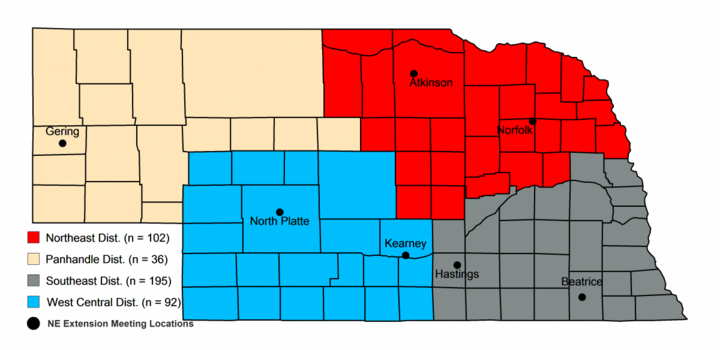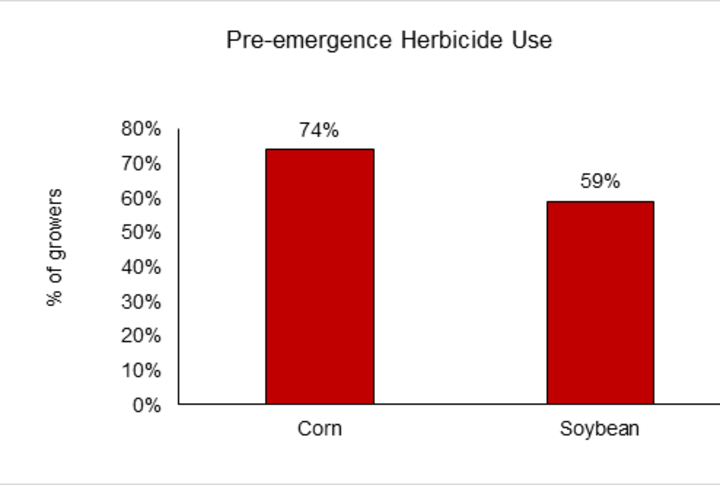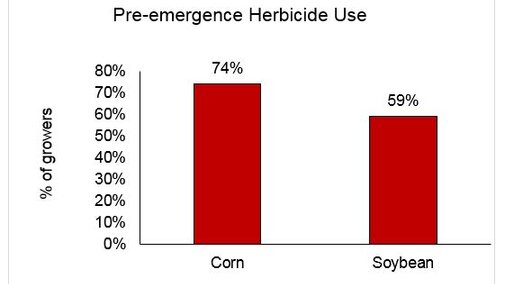A total of 425 responses (growers: 151, crop consultants: 113, and others: 161) were represented in the final survey report. Stakeholders were asked questions on four topics:
- Crop Production and Problem Weeds
- Herbicide Use
- Glyphosate-Resistant Weed Management
- Weed Management Research and Extension Priorities
Crop Production and Problem Weeds
Survey results showed that corn and soybean were the major crops in Nebraska. Less than 20% of the total area was planted with alfalfa, dry edible bean, grain sorghum, hay, proso millet, sugarbeet, and wheat. The greatest crop diversity was in the Panhandle district.
In Nebraska the most problematic weeds were common waterhemp, marestail, and kochia, followed by velvetleaf, common lambsquarters, Palmer amaranth, and giant ragweed.

Respondent Profile
- 61% of total farmed or scouted cropland was in no-till production
- 82% of total farmed or scouted cropland was in corn and soybean production
- 60% of the growers reported having at least one glyphosate-resistant weed on their farm
- 34% of growers rotated glyphosate-resistant crops with non-glyphosate-resistant crops
| Rank | Northeast | Panhandle | Southeast | West Central |
|---|---|---|---|---|
| 1 | Common waterhemp | Kochia | Common waterhemp | Kochia |
| 2 | Marestail | Common lambsquarters | Marestail | Common waterhemp |
| 3 | Velvetleaf | Field bindweed | Kochia | Marestail |
| 4 | Kochia | Palmer amaranth | Velvetleaf | Palmer amaranth |
| 5 | Giant ragweed | Canada thistle | Common lambsquarters | Foxtails |
The majority of growers and crop consultants who responded were concerned about the evolution and spread of the ALS inhibitor-resistant (for example, Classic, Pursuit, and Sceptor) and glyphosate-resistant weeds, such as common waterhemp, marestail, kochia, Palmer amaranth, and giant ragweed. In this survey, 40%, 26%, 23%, and 11% of growers reported having no, one, two, and three or more glyphosate-resistant weed species, respectively, on their farm.
Herbicide Use
Respondents indicated that residual herbicides applied pre-emergence followed by post-emergence application of glyphosate tank-mixed with other herbicides was the most effective weed management option (Figure 2). Of the growers, 72% indicated using at least one pre-plant burndown herbicide in the spring. Glyphosate, 2,4-D, and Sharpen (saflufenacil) were the most commonly used pre-plant burndown herbicides listed in the survey.

| Rank | Field Corn | Soybean | Grain Sorghum |
|---|---|---|---|
| 1 | Lexar EZ/Lumax EZ | Authority First/Sonic | Bicep II Magnum |
| 2 | Corvus | Valor/Valor XLT | Lexar/Lumax |
| 3 | Degree Xtra/Harness Xtra / Keystone NXT | Enlite/Envive | Atrazine |
The majority of corn and soybean acres were treated with glyphosate. Select Max was also listed among the most commonly used soybean post-emergence herbicides to control volunteer corn and other grass weeds.
| Rank | Field Corn | Soybean | Grain Sorghum | Wheat |
|---|---|---|---|---|
| 1 | Glyphosate | Glyphosate | 2,4-D | 2,4-D |
| 2 | Halex GT | Cadet | Dicamba | Ally XP |
| 3 | Status | Select Max and Cobra | Huskie and Permit | Amber/Rave |
Glyphosate-Resistant Weed Management
Growers and crop consultants reported that their average weed management cost in corn and soybean were $36 and $33 per acre, respectively. Cost of weed management for sugarbeet, which was only reported from the Panhandle District, was $43 per acre.
In this statewide survey, 80% of the respondents expressed their concerns regarding the volatility/physical drift of 2,4-D and dicamba following the commercialization of new crop technologies (Roundup Ready 2 Xtend and Enlist). However, misapplication of the herbicides, temperature inversion, tank contamination, and evolution of herbicide-resistant weeds were other concerns.
Weed Management Research and Extension Priorities
Herbicide-resistant weed management was identified by 48% of respondents as their top priority for research and extension. A variety of other topics, such as the development of new herbicide modes-of-action, integrated pest management, reducing off-target herbicide movement, cover crops, and farm safety were also listed as research and extension priorities.
Read More
The survey results were published recently in the Weed Technology journal. A copy is also available here.

